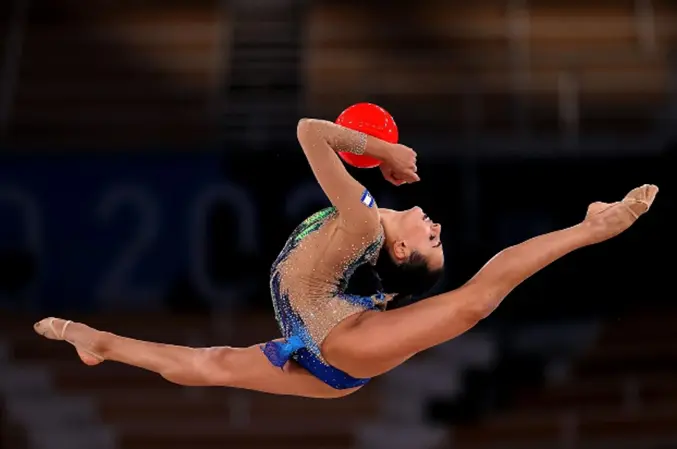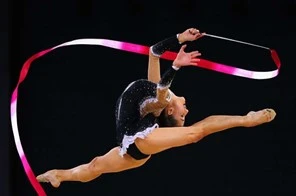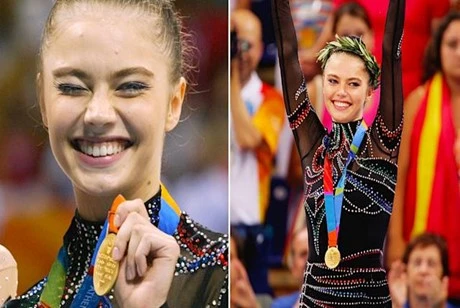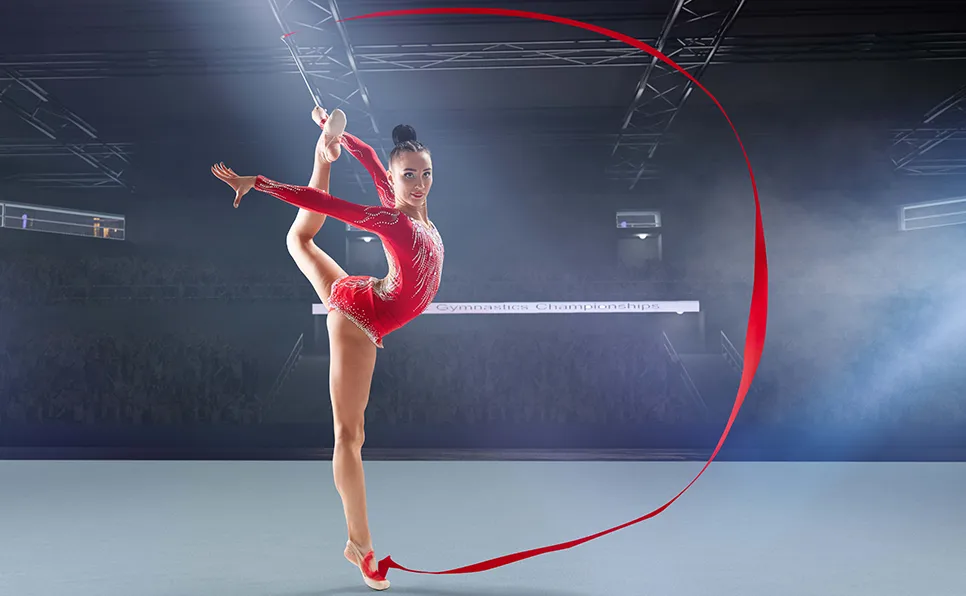Introduction:
Rhythmic Gymnastics is a sport that combines athleticism, grace, and creativity. It’s a form of gymnastics performed with apparatus such as a ball, hoop, ribbon, clubs, and rope. It requires athletes to perform a series of choreographed movements set to music. This sport is one of the most exciting in the world, as it requires athletes to combine their physical and mental skills to achieve a harmonious performance.
Rhythmic Gymnastics is a highly technical sport that requires strength, flexibility, balance, and coordination. Athletes must demonstrate their abilities to perform a variety of skills while maintaining control of their apparatus. This sport is challenging and exciting and provides numerous benefits for athletes of all ages.
Benefits of Rhythmic Gymnastics:
Rhythmic Gymnastics is an excellent sport for individuals who want to improve their physical, mental, and social well-being. Here are some of the benefits of participating in Rhythmic Gymnastics:
Improved flexibility: Rhythmic Gymnastics requires athletes to perform various stretches and movements that help improve flexibility and prevent injuries.
Enhanced coordination: The sport involves the use of apparatus and requires athletes to perform choreographed movements, which helps improve coordination and motor skills.
Increased strength: Rhythmic Gymnastics requires athletes to perform routines that involve physical strength, which helps improve overall muscular endurance and strength.
Improved balance: The sport requires athletes to maintain balance and control while performing complex movements, which helps improve overall balance and body awareness.
Boosts mental focus: Rhythmic Gymnastics requires athletes to concentrate and focus on their routines, which helps improve mental focus and discipline.
Builds teamwork: The sport provides opportunities for athletes to work together in a team, which helps build teamwork and collaboration skills.
Builds confidence: Rhythmic Gymnastics helps build confidence by allowing athletes to showcase their skills and abilities in front of others.
Enhances creativity: The sport allows athletes to express creativity through choreography, music, and costumes.
Provides social benefits: Rhythmic Gymnastics provides opportunities for athletes to make friends and socialize with others who share their interests.
Provides a sense of accomplishment: The sport provides opportunities for athletes to set and achieve goals, which can give a sense of accomplishment and fulfillment.
How to do Rhythmic Gymnastics:
Rhythmic Gymnastics requires a lot of practice, discipline, and hard work to master. Here are some steps to follow if you want to get started with Rhythmic Gymnastics:
Find a gym: Look for a gym that offers Rhythmic Gymnastics classes or programs. You can search online or ask for recommendations from friends or family members.
Get the right equipment: You’ll need to purchase the appropriate equipment for Rhythmic Gymnastics, such as a ball, hoop, ribbon, clubs, and rope. You can buy these items from a gymnastics store or online.
Attend classes regularly: Learn the techniques and skills required for Rhythmic Gymnastics. Practice under the guidance of a coach who can help you perfect your style and provide feedback.
Practice regularly: Practice regularly to improve your skills and build your stamina. A consistent approach will help you achieve your goals and improve your performance.
Participate in competitions: Compete in local, regional, and national competitions to showcase your skills and gain experience.
10 Reasons Why Rhythmic Gymnastics is the Most Exciting Sport:
Combination of athleticism and artistry:
Rhythmic Gymnastics combines athleticism with artistry in a way that is unique among sports. Athletes must be strong, flexible, and coordinated to perform the technical elements of the sport while also showcasing their creative expression through their movements.

The use of apparatus:
It adds an extra layer of excitement and complexity to Rhythmic Gymnastics. Athletes must maintain control of their devices while performing complex movements, making for a visually stunning and challenging performance.
Beautiful costumes:
The costumes worn by Rhythmic Gymnastics athletes are often intricate and beautifully designed, adding to the overall aesthetic of the performance. These costumes are carefully chosen to complement the athlete’s routine and enhance the visual impact of their movements.
Music:
Rhythmic Gymnastics routines are performed to music, which adds an emotional element to the performance. Athletes often choose music that evokes a particular mood or feeling and use it to guide the pace and rhythm of their routine.
Expressive choreography:
Rhythmic Gymnastics routines are choreographed to showcase the athlete’s strengths and abilities. It allows athletes to express themselves through movements, making each routine unique and captivating.
International competitions:
Rhythmic Gymnastics is a global sport, with athletes from all over the world competing against one another. These competitions are often highly anticipated events, with audiences tuning in from around the globe to watch the world’s best athletes compete.
A diverse range of skills:
Rhythmic Gymnastics requires athletes to demonstrate a diverse range of skills, including flexibility, balance, strength, coordination, and agility. These skills are often displayed in complex and challenging movements, making for a dynamic and exciting performance.
Unpredictable outcomes:
Rhythmic Gymnastics routines are judged based on a variety of factors, including technique, difficulty, and artistic expression. It means that the result of a competition is often unpredictable, adding to the excitement of the sport.
Spectacular throws and catches:
Rhythmic Gymnastics routines often involve spectacular throws and catches, where athletes must toss and catch their apparatus with precision and grace. These elements add an extra layer of risk and excitement to the performance.

Athletes push the boundaries:
Rhythmic Gymnastics is a sport where athletes constantly push the boundaries of what is possible. They continuously develop new and innovative routines, experiment with new techniques and movements, and find new ways to showcase their creativity and athleticism. It makes for a sport that is constantly evolving and always exciting.
Most historic performance ever:

Many historic Rhythmic Gymnastics performances have been staged throughout the sport’s history, making it difficult to choose just one. However, one of the most iconic performances in Rhythmic Gymnastics history is the gold medal-winning routine performed by Alina Kabaeva at the 2004 Athens Olympics.
Alina Kabaeva, a Russian athlete, had been dominating the sport for years, and many considered her the greatest Rhythmic Gymnast of all time. At the 2004 Athens Olympics, Kabaeva performed a truly awe-inspiring routine. Set to the haunting melody of “The Swan” from Camille Saint-Saëns’ “The Carnival of the Animals,” Kabaeva’s routine was a masterclass in grace, elegance, and technical skill.
Kabaeva displayed incredible flexibility, balance, and control over her apparatus throughout her routine, performing a series of complex movements that left the audience in awe. Her routine culminated in breathtaking throws and catches, executed with precision and grace.
Kabaeva’s performance was a valid showcase of the artistry and athleticism of Rhythmic Gymnastics, and it remains one of the most iconic performances in the sport’s history. Her gold medal-winning routine was a testament to her skill, dedication, and passion for the sport, inspiring countless athletes, and fans worldwide.
Conclusion:
Rhythmic Gymnastics is a sport that combines athleticism, grace, and creativity. It’s a highly technical sport that requires strength, flexibility, balance, and coordination. Participating in Rhythmic Gymnastics provides numerous benefits, including improved flexibility, coordination, strength, balance, mental focus, teamwork, confidence, creativity, socialization, and a sense of accomplishment.
Rhythmic Gymnastics is the most exciting sport for numerous reasons, including the combination of athleticism and artistry, the use of apparatus, beautiful costumes, music, expressive choreography, international competitions, a diverse range of skills, unpredictable outcomes, spectacular throws and catches, and the fact that athletes are constantly pushing the boundaries of what is possible. Whether you are a participant or a spectator, Rhythmic Gymnastics is a sport that will captivate and inspire.



